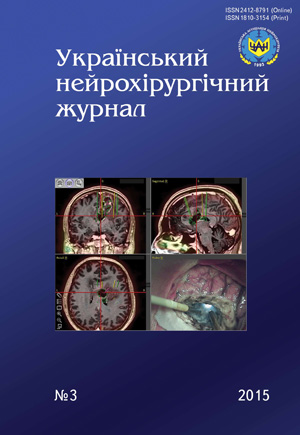Trigeminal nerve dysfunction in patients with cranial base tumors
DOI:
https://doi.org/10.25305/unj.50055Keywords:
trigeminal nerve, trigeminal neuralgia, cranial base tumors, surgical managementAbstract
Introduction. Impaired function of the trigeminal nerve is often the first and sometimes the only symptom of cranial base tumors.
Materials and methods. Analysis of trigeminal nerve dysfunction before and after intervention in 38 patients operated on different cranial base tumors was performed. Totally 40 intervention were performed. There were 21 supratentorial (17 sphenoid wings meningiomas and 4 trigeminal neuromas), 8 subtentorial (2 acoustic schwannomas, 5 CPA meningiomas, 1 chordoma) and 9 sub-supratentorial (6 petroclival meningiomas, 3 trigeminal neuromas) tumors. Tumors were removed totally in 23 (60,5%), subtotally in 11 (29%) and partially in 4 (10,5%) cases.
Results. Gasserian ganglion and trigeminal root decompression assured complete pain release in 27 patients. In 5 patients postop hemifacial hypesthesia was observed, followed by III nerve pulsy in 1, VI nerve pulsy in 2. There were no septic or fatal complications.
Conclusions. Following the rules of scull base surgery and microsugical technic assured good postop result in this group of patients.
References
1. Konovalov AN, editor. Khirurgiya opukholey osnovaniya cherepa [Surgery of the skull base tumors]. Moscow: Burdenko Institute of Neurosurgery; 2004. Russian .
2. Shulev Y, Trashin A, Gorodienko K. Secondary trigeminal neuralgia in cerebellopontine angle tumors. Skull Base. 2011;21(5.):287-294; [CrossRef]
3. Tan L, Gerard C, Ahuja S, Moftakhar R. Retrosigmoid approach for resection of cerebellopontine angle meningioma and decompression of the trigeminal nerve. Neurosurgical Focus. 2014;36(V1Supplement):1-1. [CrossRef] [PubMed]
4. Ramina R, Mattei TA, Sória MG, da Silva EB Jr, Leal AG, Neto MC, Fernandes YB. Surgical management of trigeminal schwannomas. Neurosurgical Focus. 2008;25(6):E6. [CrossRef] [PubMed]
5. Khan Afridi EA, Khan SA, Quershi WU, Bhatti SN, Muhammad G, Mahmood S, Rehman A. Frequency of cerebellopontine angle tumors in patients with trigeminal neuralgia. J. Ayub. Med. Coll. Abbottabad. 2014;26(3):331-333. [PubMed]
6. Feiz-Erfan I, Spetzler RF, Porter RW, Beals SP, Lettieri SC, Joganic EF, Demonte F. Proposed classification for the transbasal approach and its modifications. Skull Base. 2008;18(1):29-47. [CrossRef] [PubMed]
Downloads
Published
How to Cite
Issue
Section
License
Copyright (c) 2015 Mykola Polishchuk, Oleksandr Voznyak, Anatoliy Kaminskiy, Andrey Oblyvach, Vakhtang Sichinava, Maksim Gudim

This work is licensed under a Creative Commons Attribution 4.0 International License.
Ukrainian Neurosurgical Journal abides by the CREATIVE COMMONS copyright rights and permissions for open access journals.
Authors, who are published in this Journal, agree to the following conditions:
1. The authors reserve the right to authorship of the work and pass the first publication right of this work to the Journal under the terms of Creative Commons Attribution License, which allows others to freely distribute the published research with the obligatory reference to the authors of the original work and the first publication of the work in this Journal.
2. The authors have the right to conclude separate supplement agreements that relate to non-exclusive work distribution in the form of which it has been published by the Journal (for example, to upload the work to the online storage of the Journal or publish it as part of a monograph), provided that the reference to the first publication of the work in this Journal is included.









